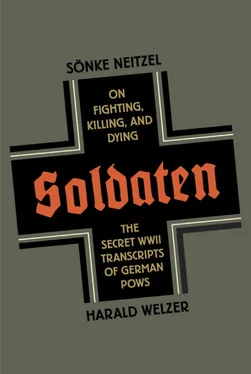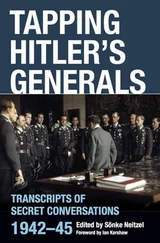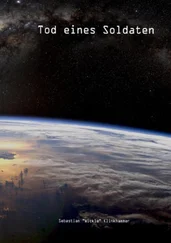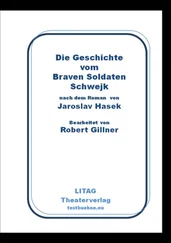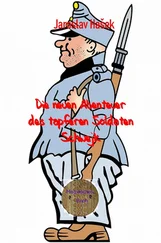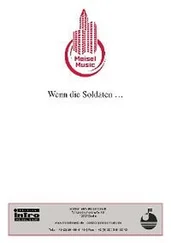SRA 5532, 25 July 1944, TNA, WO 208/4134.
SRA 2058, 2 August 1941, TNA, WO 208/4125.
SRA 2660, 18 June 1942, TNA, WO 208/4126. Zastrau was a member of 5/KG 2 and was shot down on 23 April 1942 over Exeter. Balke, Luftkrieg in Europa, p. 430.
SRA 4862, 23 January 1944, TNA, WO 208/4132. This description refers to the German bombardment of Bari during the night of 3 December 1943. German bombs and explosions aboard the ammunition carriers John E. Motley and Joseph Wheeler, as well as the tanker ship Aroostock, destroyed eighteen ships with a gross tonnage of 71,566. There were more than 1,000 dead and wounded. Firefighting and rescue attempts were hindered by the fact that the U.S. freighter John Harvey was carrying mustard gas. http://www.wlb-stuttgart.de/seekrieg/43–12.htm(accessed 30 August 2010).
SRA 1557, 23 April 1941, TNA, WO 208/4123.
SRM 606, 27 June 1944, TNA, WO 208/4138.
Förster, in Das Deutsche Reich, Vol. 9/1, p. 469.
SRA 281, 4 August 1940, TNA, WO 208/4137.
SRA 453, 4 September 1940, TNA, WO 208/4137.
SRA 450, 4 September 1940, TNA, WO 208/4137.
SRA 549, 17 September 1940, TNA, WO 208/4138.
Wilhelm von Thoma diary entry, 21 January 1942, BA/MA, N 2/2.
SRA 2655, 18 June 1942, TNA, WO 208/4126; see also SRA 2635, 15 June 1942, TNA, WO 208/4127.
Förster, in Das Deutsche Reich, Vol. 9/1, p. 540.
Hans Meier-Welcker, Aufzeichnungen eines Generalstabsoffiziers, 1919 bis 1942 (Freiburg: Rombach Druck- und Verlagshaus, 1982), p. 158 (23 August 1942).
SRN 129, 15 November 1940, TNA, WO 208/4141.
SRN 395, 8 June 1941, TNA, WO 208/4142.
SRN 183, 21 March 1941, TNA, WO 208/4141.
SRN 370, 28 May 1941, TNA, WO 208/4142.
SRN 127, 16 November 1940, TNA, WO 208/4141.
SRN 720, 25 December 1941, TNA, WO 208/4143.
For the results of the questionnaires filled out by German POWs November 1941–March 1943, see TNA, WO 208/4180.
SRN 690, 7 November 1941, TNA, WO 208/4143.
SRN 933, 31 March 1942, TNA, WO 208/4143. Josef Przyklenk (born 10 January 1914) was machinist aboard U-93 and was captured on 15 January 1942.
SRN 731, 31 December 1941, TNA, WO 208/4143. The British listed him, in contrast to the crew registry, as Karl Wede kinn .
SRN 969, 22 August 1942, TNA, WO 208/4143; SRN 968, 22 August 1942, TNA, WO 208/4143. U-210 was sunk on her maiden patrol.
Bernhard R. Kroener, “‘Nun Volk steht auf…!’ Stalingrad und der totale Krieg, 1942–1943,” in Stalingrad: Ereignis, Wirkung, Symbol, Jurgen Förster, ed. (Munich: Piper, 1992), pp. 151–70; Martin Humbug, Das Gesicht des Krieges: Feldpostbriefe von Wehrmachtssoldaten aus der Sowjetunion, 1941–1944 (Opladen: Westdeutscher Verlag, 1998), p. 118ff.
SRA 3717, 2 March 1943, TNA, WO 208/4129.
SRA 3442, 28 December 1942, TNA, WO 208/4128.
SRA 3868, 22 March 1943, TNA, WO 208/4129.
SRA 4012, 18 May 1943, TNA, WO 208/4130; SRA 4222, 28 July 1943, TNA, WO 208/4130. There were opinions like this in the navy, but not in the army. See SRN 1643, 14 April 1943, TNA, WO 208/4145.
SRA 4791, 6 January 1944, TNA, WO 208/4132.
The reference is to the commander of the II/KG 2, Major Heinz Engel, who had joined the group in October 1941 and had led it since February 1943. Balke, Luftkrieg in Europa, p. 409.
SRA 5272, 16 May 1944, TNA, WO 208/4133.
Ibid.
SRA 4747, 22 December 1943, TNA, WO 208/4132.
SRN 2509, 27 November 1943, TNA, WO 208/4148.
See SRN 2521, 11 December 1943, TNA, WO 208/4148.
SRN 2768, 17 January 1944, TNA, WO 208/4149. Even weapons of retribution seemed to hold out little hope in this regard. SRN 3613, 8 May 1944, TNA, WO 208/4152.
“Erlass gegen Kritiksucht und Meckerei,” 9 September 1943, cited in Salewski, Seekriegsleitung, p. 638ff.
The British forced some of the POWs in the surveillance camps to fill out standardized questionnaires. Between March 1943 and January 1944, they surveyed five groups of 35 to 71 men, 240 in total. The majority came from the German navy, a smaller percentage from the Luftwaffe. CSDIC (UK), Survey of German P/W Opinion, GRS 10, 24 February 1944, TNA, WO 208/5522.
Rafael A. Zagovec, “Gespräche mit der ‘Volksgemeinschaft’” in Die deutsche Kriegsgesellschaft, 1939 bis 1945—Ausbeutung, Deutungen, Ausgrenzung, Vol. 9/2, Militärgeschichtliches Forschungsamt, ed. (Stuttgart: Deutsche Verlags-Anstalt, 2005), p. 327.
Jörg Echternkamp, “Im Kampf an der inneren und äußeren Front: Grundzüge der deutschen Gesellschaft im Zweiten Weltkrieg,” in Das Deutsche Reich, Vol. 9/1, p. 47.
Heinz Boberach, ed., Meldungen aus dem Reich (Munich: Pawlak Verlag Herrsching, 1968), p. 511.
Michael Salewski, “Die Abwehr der Invasion als Schlüssel zum ‘Endsieg’?” in Die Wehrmacht, Mythos und Realität, Rolf-Dieter Müller, and Hans-Erich Volkmann, eds. (Munich: Oldenbourg Wissenschaftsverlag, 1999), pp. 210–23.
SRM 519, 7 June 1944, TNA, WO 208/4138.
SRM 526, 9 June 1944, TNA, WO 208/4138.
SRM 547, 13 June 1944, TNA, WO 208/4138.
SRM 606, 27 June 1944, TNA, WO 208/4138. Kuhle was the commander of III/IR 1050 of the 77th Infantry Division, while Saldern led the dramatically weakened Grenadier Regiment 1057 of the 91st Airborne Division. Major Bornhard, commander of the Feldersatzbataillon of the 77th Infantry Division, was captured on 18 June 1944 and was interned together with Kuhle at Wilton Park. From 1 February to 25 April 1944, Lieutenant General Walter Poppe commanded the 77th Infantry Division, in which Kuhle served. On 5 July, Poppe took over a new command. The basis for the rumors of treason is unclear.
SRM 610, 29 June 1944, TNA, WO 208/4138.
SRM 830, 24 August 1944, TNA, WO 208/4139.
SRM 849, 27 August 1944, TNA, WO 208/4139.
For a summary of current research, see Neitzel, Abgehört, p. 61ff.
Читать дальше
